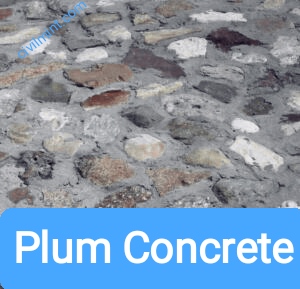Table of Contents
What is Plum Concrete?
Plum concrete is a type of concrete in which medium and large sized stone aggregates are utilised to make concrete. These stone aggregates works as a filler material.

Some other names of plum concrete are cyclopian concrete and rubble concrete. It is a mixture of wet concrete and plums. Plus are large and strong clean natural coarse aggregates or cobblestones, about 300 mm or more in size. Plums make up about 30-40% of the total mass of concrete.
Adding plum to concrete reduces the heat of hydration as it prevents the use of excessive amounts of cement without sacrificing strength.
Plum concrete is mainly used where mass concrete is required, such as gravity dams, embankments, filling deep or uneven areas, and foundation construction. It is therefore an economical alternative to conventional concrete.
Plum Concrete Ratio
The plum concrete ratio should be 40/60, 40% plum and 60% mix concrete such as M10 or M15. Concrete quality M15 is usually used. Plums over 160 mm and properly sized plums can be used in his PCC work up to 20% of the concrete volume. This design mix should be approved by project management consultant.
I would also recommend to read my article on mix design calculation for M20, M25 and M30 concrete.
Characteristics
- Plums are natural stone. Plum is about 150mm, 200mm, 300mm or more. Sizes are selected based on project, material availability, and technical decisions.
- Square stones are suitable for making plum concrete.
- Plums should be clean and free of oil, dirt, or other harmful substances that might interfere with proper adhesion or adhesion to concrete.
- It must be of good quality, solid, durable and free of separations, seams, tears and other structural flaws and imperfections. Plums should also not be worn, weathered or have rounded surfaces.
Casting Procedure of Plum Concrete
- Spray water on the surface where the plum concrete will be placed. After that, a termite-preventing agent, which is indispensable for the start-up of the structure, is sprayed.
- At least he puts in two layers of concrete to make sure the bottom of the boulder is embedded in the concrete, eliminating voids in the bottom.
- Next, place the natural stone carefully, being careful not to let it fall on the concrete. The distance between the two stones or between the stone and the mold should not exceed 50 mm. Concrete is laid layer by layer until the required level is reached.
- The thickness of each layer shall not exceed 900mm.
- Plum concrete takes at least 7 days to harden.
Uses of Plum Concrete
- Reduce construction costs by leveling deep pits and uneven surfaces at the bottom of foundation excavations. This way you reach the lowest level or foundation bed using cheap and strong materials.
- Construct concrete foundation and footing foundation.
- Crushed concrete is used in areas where large-scale concrete is required. Examples: Concrete embankments, piers, side slopes, barriers.
- Plum concrete, made from a mixture of 150 mm of cobblestone and at least 173 kgm3 of cement, was used to construct the real dam. Reduce the cost of thick Portland cement concrete.
- It is used to build machine foundations where large amounts of concrete are required for foundation and machine safety.
- Used in the construction of canal beds
